We’ve all been there, navigating a dark kitchen at night, trying not to wake anyone while searching for that late-night snack. The frustration of harsh overhead lights or stubbed toes on cabinet corners is all too real. Under-cabinet motion lights have emerged as the elegant solution to this common household challenge, transforming how we interact with our kitchens during those quiet hours and busy cooking sessions alike.
But here’s the thing: not all under-cabinet motion lights are created equal. After spending countless hours researching, testing, and yes, making some costly mistakes, I’ve learned that the difference between a brilliant investment and buyer’s remorse often comes down to understanding what truly matters before you buy.
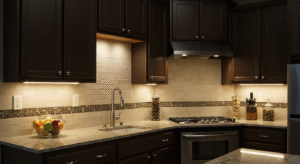
Why Under-Cabinet Motion Lights Are More Than Just Trendy Gadgets
Under-cabinet motion lights have evolved from simple convenience features to essential kitchen upgrades that enhance both functionality and ambience. They eliminate harsh overhead lighting for late-night activities, provide targeted task lighting for food prep, and add a sophisticated aesthetic that many homeowners didn’t know they were missing.
The real magic happens when you realise these lights aren’t just about illumination—they’re about creating an intuitive living space that responds to your needs without constant manual intervention
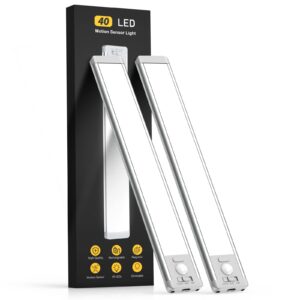
20 Critical Points to Consider Before Making Your Purchase
Power and Performance Factors
1. Motion Sensor Range and Sensitivity
The detection range varies dramatically between models, from 3 feet to 15 feet. Consider your kitchen layout carefully. A narrow galley kitchen needs different sensitivity than an open-concept space. Look for adjustable sensitivity settings to fine-tune performance after installation.
2. Light Output and Colour Temperature
Measured in lumens, brightness requirements depend on your intended use. For ambient lighting, 150-300 lumens per foot works well. Task lighting needs 300-500 lumens per foot. Colour temperature matters too—3000K provides warm, cosy light, while 4000K offers crisp, clean illumination for food preparation.
3. Battery Life vs. Hardwired Options
Battery-powered units offer easy installation but require regular maintenance. Quality models provide 6-12 months of battery life with normal use. Hardwired options eliminate battery concerns but require electrical work. Consider your DIY comfort level and long-term maintenance preferences.
4. LED Quality and Lifespan
Not all LEDs are equal. Look for models with high-quality chips rated for 50,000+ hours. Cheaper LEDs may dim significantly over time or develop uneven lighting patterns. Brand reputation often correlates with LED quality.
Installation and Compatibility
5. Mounting Options and Cabinet Compatibility
Different mounting systems work better with various cabinet styles. Magnetic mounts work well with metal cabinets, while adhesive strips suit most surfaces. Some models require screws for secure installation. Measure your cabinet lips and available space before purchasing.
6. Wire Management and Connectivity
If choosing hardwired or interconnected systems, consider wire routing options. Some models offer wireless connectivity between units, while others require physical wiring. Plan your installation route to avoid visible wires and potential damage.
7. Smart Home Integration Capabilities
Modern under-cabinet lights increasingly offer smart home compatibility. Integration with Alexa, Google Home, or Apple HomeKit allows voice control and automated schedules. Consider whether this feature aligns with your existing smart home ecosystem.
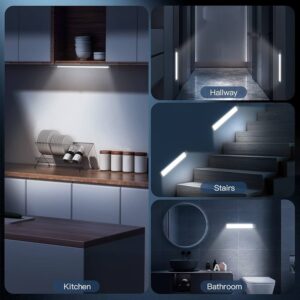
User Experience and Functionality
8. Activation Timer Settings
The automatic shut-off timer prevents unnecessary battery drain and provides convenience. Look for adjustable timers ranging from 20 seconds to 10 minutes. Some models offer multiple timer options for different usage scenarios.
9. Manual Override Options
Sometimes you need continuous lighting without motion activation. Models with manual override switches provide flexibility for extended cooking sessions or when motion detection isn’t practical.
10. Dimming Capabilities
Adjustable brightness enhances versatility. Some models offer multiple brightness levels, while others provide smooth dimming. This feature proves invaluable for creating different moods or accommodating various tasks.
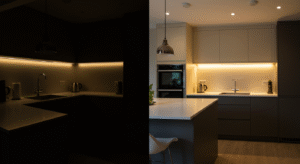
Design and Aesthetics
11. Light Distribution and Beam Angle
Even light distribution eliminates hot spots and shadows. Look for models with wide beam angles (120+ degrees) for uniform coverage. Some units use diffusers to create smooth, professional-looking illumination.
12. Housing Design and Finish Options
The light housing should complement your kitchen’s aesthetic. Options range from sleek aluminium to discrete plastic housings. Consider whether you want the fixtures visible or hidden, and choose finishes that match your cabinet hardware.
13. Size and Profile Considerations
Measure your available space carefully. Low-profile designs work better in tight spaces, while larger units may provide better light output. Consider both the fixture depth and length when planning your installation.
Technical Specifications
14. IP Rating for Moisture Protection
Kitchens present moisture challenges from cooking steam and cleaning. Look for IP44 or higher ratings for adequate protection. This ensures longevity and prevents damage from normal kitchen humidity.
15. Operating Temperature Range
Kitchen temperatures fluctuate significantly during cooking. Ensure your chosen lights can handle heat from cooking appliances and maintain performance across temperature variations.
16. Interference and False Triggering
Some motion sensors trigger incorrectly due to heat from appliances, air movement, or even pets. Look for models with advanced motion detection algorithms that minimise false activations while maintaining sensitivity.
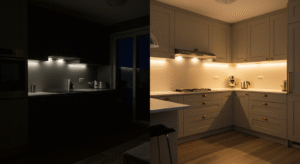
Value and Long-term Considerations
17. Energy Efficiency and Operating Costs
LED efficiency varies between manufacturers. Look for models with high lumens-per-watt ratios. While the difference seems small, it adds up over the fixture’s lifespan, especially for hardwired units that might run more frequently.
18. Expandability and Modularity
Consider whether you might want to add more lights later. Some systems allow easy expansion with additional units that sync with your existing setup. This flexibility proves valuable as your needs evolve.
19. Warranty and Customer Support
A solid warranty indicates a manufacturer’s confidence in their product. Look for at least a one-year warranty, with two or more years being preferable. Research customer service reputation for problem resolution.
20. Real-world Reviews and Performance
Beyond marketing claims, seek authentic user reviews focusing on long-term performance. Pay attention to comments about battery life, motion sensitivity, and durability over time. Professional reviews often provide valuable technical insights.
The perfect under-cabinet motion light system balances your specific needs with practical considerations. A busy family kitchen has different requirements than a minimalist apartment setup. Consider your cooking habits, aesthetic preferences, and technical comfort level when weighing these factors.
Remember that the cheapest option rarely provides the best value, while the most expensive doesn’t guarantee superiority. Focus on features that matter most for your situation, and don’t pay for capabilities you’ll never use.
Transform Your Kitchen Experience Today
Under-cabinet motion lights represent one of those rare home improvements that provide immediate, noticeable benefits while adding long-term value. They’re not just about convenience—they’re about creating a more intuitive, efficient, and enjoyable kitchen environment.
The key lies in understanding your specific needs and choosing accordingly. Whether you prioritise easy installation, smart home integration, or simply reliable performance, there’s a solution that fits your requirements and budget.
Your midnight snack runs will never be the same, and neither will your cooking experience. The investment in quality under-cabinet motion lights pays dividends in daily convenience, enhanced functionality, and that subtle satisfaction of a truly well-designed living space.
Ready to upgrade your kitchen lighting? Take time to evaluate these 20 points against your specific needs, and you’ll make a choice that enhances your home for years to come.

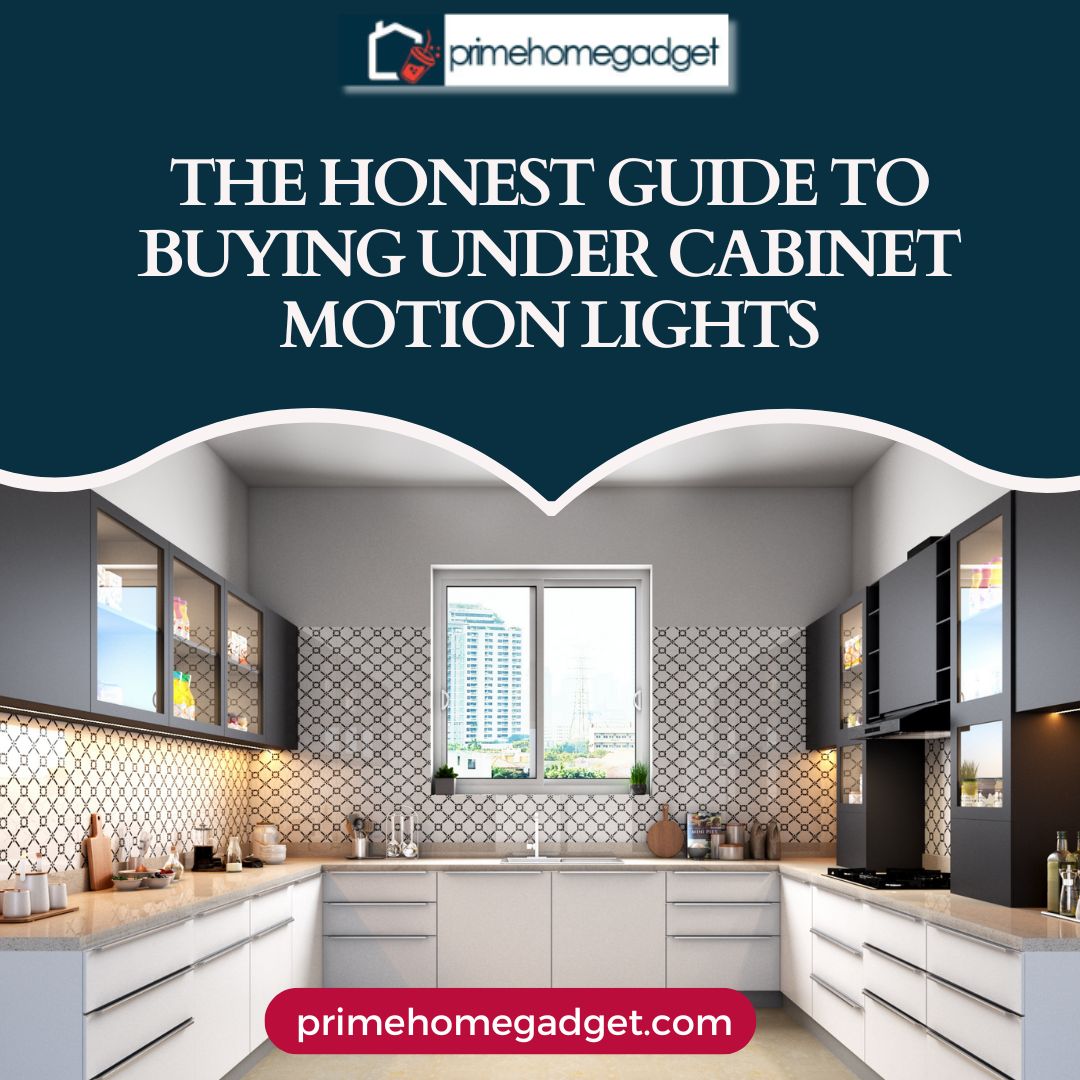
Write a Comment